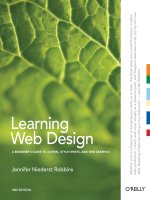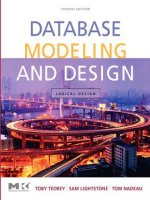Studio Photography Essential Skills, 4th Edition P1 ppt
Bạn đang xem bản rút gọn của tài liệu. Xem và tải ngay bản đầy đủ của tài liệu tại đây (460.74 KB, 10 trang )
Studio Photography
Essential Skills
John Child
Fourth Edition
AMSTERDAM • BOSTON • HEIDELBERG • LONDON • NEW YORK • OXFORD
PARIS • SAN DIEGO • SAN FRANCISCO • SINGAPORE • SYDNEY • TOKYO
Focal Press is an imprint of Elsevier
Focal Press is an imprint of Elsevier
Linacre House, Jordan Hill, Oxford OX2 8DP
30 Corporate Drive, Burlington MA 01803
First published 1999
Reprinted 2000
Second edition 2001
Reprinted 2003 (twice)
ird edition 2005
Fourth edition 2008
Copyright 2008, John Child. All rights reserved
e right of John Child to be identified as the author of this work has been asserted in
accordance with the Copyright, Designs and Patents Act 1988
No part of this publication may be reproduced, stored in a retrieval system or transmitted
in any form or by any means electronic, mechanical, photocopying, recording or otherwise
without the prior written permission of the publisher
Permissions may be sought directly from Elsevier’s Science & Technology Rights Department
in Oxford, UK: phone (+44) (0) 1865 843830; fax (+44) (0) 1865 853333; email:
Alternatively you can submit your request online by visiting the
Elsevier website at and selecting Obtaining permission
to use Elsevier material
Notice
No responsibility is assumed by the publisher for any injury and/or damage to persons
or property as a matter of products liability, negligence or otherwise, or from any use
or operation of any methods, products, instructions or ideas contained in the material herein
British Library Cataloguing in Publication Data
A catalogue record for this book is available from the British Library
Library of Congress Cataloguing in Publication Data
A catalog record for this book is available from the Library of Congress
ISBN 978-0-240-52096-4
Printed and bound in Canada
08 09 10 11 11 10 9 8 7 6 5 4 3 2 1
For more information on all Focal Press publications visit our website at:
www.focalpress.com
iii
Contents
Acknowledgement s
Among the many people who have helped make this book possible, I wish to express my
thanks to the following:
Mark Galer, Les Horvat and Michael Wennrich for their help and advice.•
e students of RMIT University, Melbourne, for their illustrative input, •
enthusiasm and friendship.
And to Gloria and my family for their continuing encouragement and •
understanding throughout my photographic career, thank you.
iv
Studio Photography: Essential Skills
Contents
1. Introduction 1
Process and progress 2
Independent learning 3
Research and resources 4
Visual Diary 5
Record Book 6
Presentation 7
History 8
Advancements in technology 9
Current commercial practice 10
Methodology 11
2. Genres 13
Introduction 14
Advertising illustration 15
Still life 16
Portraiture 17
Commercial portraiture 18
Fashion 19
Fashion since 1950 20
3. Communication and design 23
Introduction 24
Context 25
Format 26
Content 27
Balance 28
Composition 29
Point of view 30
Line 31
Depth 33
Perspective 34
4. Art direction 37
Introduction 38
Layouts 39
Framing the image 40
v
Contents
5. The studio 45
Introduction 46
Health and safety 47
Equipment 48
Camera 49
Lenses 50
Light sources 52
Equipment detail 53
Organisation 55
6. Light 59
Introduction 60
Artificial light 61
Characteristics of light 63
7. Exposure 73
Introduction 74
Aperture and time 75
Light meter 77
Using the light meter 78
Lighting ratios 80
Interpreting the meter reading 82
Exposure compensation 84
Digital exposure 86
8. Image capture 93
Introduction 94
Choosing a capture medium 95
Digital capture 96
Latitude 97
Limitations of film capture 98
Push and pull 99
Cross processing 100
Image preview 101
vi
Studio Photography: Essential Skills
9. Creative controls 103
Introduction 104
Focus 105
Depth of field 106
Selective focus 108
Preview 109
Duration of exposure 110
Creative exposure compensation 111
Perspective 112
10. Using light 115
Introduction 116
Working with studio lights 117
Flash 118
Tungsten 120
Diffusion 122
Reflection 123
Filtration 124
Mixed light sources 125
Illusion of movement 126
11. Lighting still life 129
Introduction 130
Assignment 1 ‘Box’ 132
Assignment 2 ‘Ball’ 134
Assignment 3 ‘Texture’ 136
Assignment 4 ‘Flowers’ 138
Assignment 5 ‘Metal’ 140
Assignment 6 ‘Desk’ 142
Assignment 7 ‘Rust’ 144
Assignment 8 ‘Black and white’ 146
Assignment 9 ‘Cutlery’ 148
12. Lighting people 151
Introduction 152
Assignment 1 ‘High key’ 154
Assignment 2 ‘Low key’ 156
Assignment 3 ‘Mid key’ 158
Pose 160
vii
Contents
13. Lighting on location 163
On location 164
Interior location 166
14. Composites 171
Composite images 172
Composite lighting 173
Comosite techniques 174
Composite solutions 178
15. Assignments 181
Introduction 182
Revision exercises 187
Glossary 199
Resources 209
Index 211
This page intentionally left blank
Introduction
Studio photography covers a wide range of disciplines. In its simplest form it is part of the
documentation process for a driver’s licence, ID, passport, etc.; at its most complex, cinematography
and its role in the creation of films. Within this spectrum fall portraiture, fashion, still life, film library,
product, advertising illustration, industrial, corporate and architectural. It may seem industrial, corporate
and architectural are not studio photography but in most situations there is inadequate or non-existent
illumination which must be supplemented or totally lit with artificial light. As lighting is the essential
element in photography it is important to understand and improve this skill, along with the many others
that contribute to the successful creation of studio images. is book deals with working in the studio
using artificial light sources and on location using combinations of existing light sources and introduced
lighting. e activities, assignments, basic photographic theory and useful practical advice provide the
essential techniques for creative and competent photography.
Acquisition of technique
is book concentrates on the acquisition and application of skills necessary for studio photography.
e emphasis is on technique, communication and design within the genres of still life, advertising
illustration, portraiture, fashion and lighting on location. Terminology is kept as simple as possible using
common usage and avoiding complicated theoretical explanations.
Application of technique
e book concludes with several chapters devoted to the practical application of the skills acquired.
Assignments can be undertaken allowing the photographer to express their ideas through the appropriate
application of design and technique. is book offers a structured learning approach that will give the
photographer a framework and solid foundation for working independently and confidently in a studio
or on location.
The essential skills
e essential skills required to become a competent photographer take time and motivation. Skills should
be practised repeatedly so they become practical working knowledge. Practise the skills obtained in one
chapter and apply them to the next. Eventually these skills can be applied intuitively or instinctively and
you will be able to communicate with clarity and creativity.
Rodrick Bond









